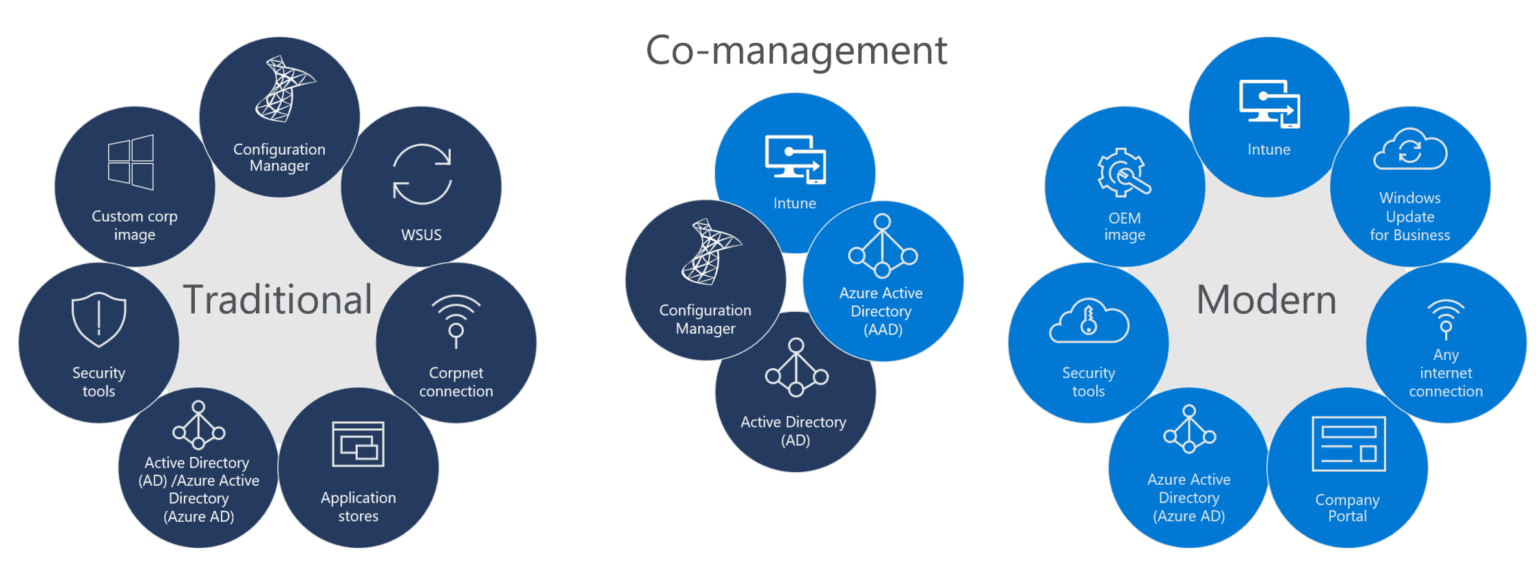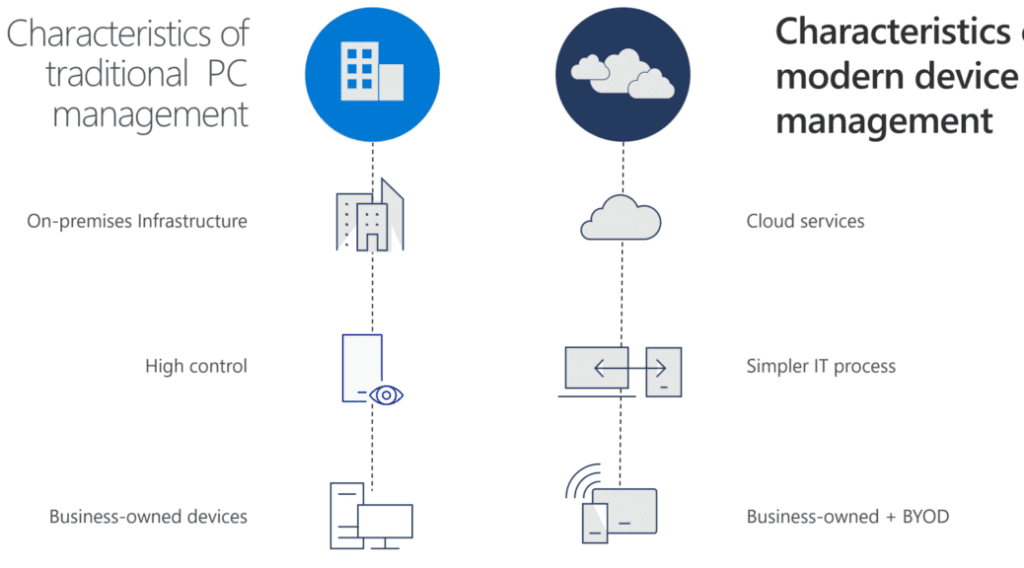The energy industry is one of the most demanding sectors, with complex operations and a constant need for innovation. As a result, energy companies need a robust and efficient desktop environment that can keep up with their demands. In recent years, more and more energy companies are considering the benefits of moving to a cloud-managed modern desktop. Cloud-managed modern desktops offer several advantages over traditional desktop environments, including enhanced scalability, accessibility, security, compliance, and cost-effectiveness. In this blog, we’ll delve deeper into the reasons why energy companies should consider moving to a cloud-managed modern desktop and how it can help them optimize their operations and stay competitive in a rapidly evolving industry.
What is a Cloud-Managed Modern Desktop?
A cloud-managed modern desktop is a virtual desktop environment that is hosted on cloud infrastructure and managed by a cloud service provider. This type of desktop environment provides a fully managed, secure, and scalable desktop experience that can be accessed from anywhere, on any device with an internet connection.
The cloud service provider manages the virtual desktop infrastructure, including the underlying servers, storage, and networking components. They also provide software updates, security patches, and technical support, making it a hassle-free option for businesses that want to outsource their desktop management.
A cloud-managed modern desktop typically consists of the following components:
- Virtual machines (VMs): VMs are created on the cloud infrastructure to host each user’s desktop environment. Each VM is isolated from other VMs on the same physical server, providing a secure and dedicated environment for each user.
- Remote desktop protocol (RDP) client: Users can access their virtual desktop environment using an RDP client, which is available for a variety of devices and operating systems.
- Web-based interface: Some cloud service providers offer a web-based interface that allows users to access their virtual desktop environment through a web browser.
- Applications: Applications can be installed on the virtual desktop environment and accessed by users through the RDP client or web-based interface. Some cloud service providers also offer application streaming, which allows users to access applications without installing them on their virtual desktop.
- Data storage: Data can be stored on the virtual desktop environment or in cloud storage services, such as OneDrive or Google Drive.


Key Benefits
While there are many benefits of deploying a Cloud-Managed Modern Desktop, the biggest ones are reduced carbon emissions and data storage cost – the two biggest plagues haunting the energy industry today.
Reduction in carbon emissions.
Directly or indirectly, the energy industry accounts for 42% of global emissions. To play its part in mitigating climate change, the energy sector must reduce its emissions by at least 3.4 gigatons of carbon-dioxide equivalent a year by 2050 —a 90% reduction in current emissions. Cloud-managed Modern Desktops can be a game changer for energy enterprises as they take on this mammoth task of net zero emissions. Here’s how.
- Reduced Hardware Footprint: Eliminates the need for on-premises hardware, such as desktops, servers, and storage devices. This reduction in hardware footprint can help energy companies reduce their carbon footprint by minimizing the environmental impact of manufacturing, shipping, and disposing of hardware.
- Energy-Efficient Infrastructure: Uses energy-efficient infrastructure to power their data centers, reducing the amount of energy required to run cloud-managed modern desktops. This approach can significantly reduce carbon emissions associated with energy consumption.
- Remote Work: Enables remote work, allowing energy company employees to work from home or other locations. This approach can reduce the need for employees to commute to and from work, reducing carbon emissions associated with transportation. Remote work can also help energy companies reduce real estate costs by requiring less office space.
- Scalability: Highly scalable, enabling energy companies to add or remove desktops as needed without managing physical hardware. This scalability can help energy companies reduce their carbon footprint by reducing the need for energy-intensive infrastructure.
- Paperless Operations: Facilitates paperless operations by providing digital document management solutions. This approach can reduce the environmental impact of paper production and disposal, contributing to a more sustainable operation.
Reduction in data storage cost
On average, there are 80,000 sensors on a modern offshore drilling platform generating data amounting to 10 TB/day. Estimates suggest that the average cost of storing a single TB of file data is now pegged at $3,351 annually. The total cost for a large-scale energy enterprise must be in millions of dollars, if not billions. Adopting a cloud-managed can help energy companies reduce their costs drastically as well as curtail data sprawl. Here’s how.
- Centralized Storage: A centralized storage solution that allows energy companies to store all their data in a single location. This can help energy companies reduce data storage costs by eliminating the need for multiple data storage solutions.
- Data Compression and Deduplication: Provides data compression and deduplication features that can help reduce the size of data stored. This feature can help energy companies reduce data storage costs by minimizing the amount of storage required.
- Pay-As-You-Go Pricing Model: Offers a pay-as-you-go pricing model, which means that energy companies only pay for the resources they use. This pricing model can help energy companies reduce data storage costs by only paying for the storage they need.
- Automatic Data Archival: Automatically archives data that is not frequently accessed, reducing the amount of storage required. This feature can help energy companies reduce data storage costs by storing less data.
- Data Governance: Provides data governance features that allow energy companies to manage their data effectively. This approach can help energy companies reduce data storage costs by ensuring that only relevant data is stored.
- Improved Productivity: Enables access to applications and data from anywhere and on any device, improving employee productivity. This approach can help energy companies optimize costs by increasing employee efficiency and reducing downtime.
- Improved Resource Utilization: Allows energy companies to optimize their resource utilization by providing on-demand access to desktops and applications. This approach can help energy companies reduce waste and optimize costs.
Metadata Analytics – The Secret to Successfully Transitioning to Cloud-Managed Modern Desktops
As organizations transition to a modern desktop, one of the most significant obstacles they face is data sprawl. Data sprawl occurs when data is scattered across various storage systems, physical locations, and environments, making it challenging to manage and secure. It also becomes more difficult to gain meaningful insights from the data. Questions arise such as: Where is the data located? Who owns it? How old is it? When was it last accessed? What percentage of the data is “hot” versus “cold”? Should all the data be stored, or can some of it be deleted, archived, or tiered? How many open shares are there?
Metadata analytics is the answer.
Metadata analytics can assist energy enterprises in efficiently adopting cloud-managed modern desktops by providing insights into the structure and organization of data, which can be useful in determining the value and strategic significance of specific data assets. This information can help to identify which data assets are critical to the business and should be retained and which can be divested. Additionally, it assists in the planning and execution of data movement by providing information on the dependencies and interrelationships between data assets, which can inform decisions on how to separate and transfer data assets between organizations. Overall, it helps to ensure that the transition is executed efficiently and effectively, with minimal disruption to the business and its stakeholders. The following are three types of metadata analytics that are useful during the adoption of the modern desktop.
- Descriptive metadata analytics: Focuses on providing basic information about the data, such as the type of data, creation date, size, format, and location.
- Contextual metadata analytics: Focuses on the context in which the data was created, such as the author, date, and source of the data.
- Behavioral metadata analytics: Focuses on the usage and access patterns of the data, such as who has access to the data, how it is used, and how it is shared.
Benefits:
- Identify Unused or Underutilized Applications: Metadata analytics can help identify applications that are not being used or are being underutilized. This information can then be used to streamline the application portfolio and reduce licensing costs.
- Determine Data Storage Needs: Metadata analytics can help energy companies understand how much data is being generated and stored by their employees. This information can then be used to optimize the adoption of cloud-managed modern desktops by ensuring that the appropriate amount of storage is allocated.
- Analyze User Behavior: Metadata analytics can help energy companies understand how their employees are using their desktops and applications. This understanding can then be used to optimize the adoption of cloud-managed modern desktops by tailoring the desktop environment to the needs of each employee.
- Improve Security: Metadata analytics can help energy companies identify security risks and vulnerabilities. This information can then be used to optimize the adoption of cloud-managed modern desktops by implementing appropriate security measures to protect against data breaches.
- Enhance Performance: Metadata analytics can help energy companies identify performance issues, such as slow application load times or network latency. This information can then be used to optimize the adoption of cloud-managed modern desktops by addressing these issues and improving overall performance.
Azure Modern Desktop – A Partner of Choice
Azure is a popular choice for companies considering migrating to cloud-managed modern desktops because it offers a range of tools and services to facilitate the transition. One of its main advantages is its seamless integration with existing on-premises infrastructure, which enables a smooth transition to the cloud. Azure Virtual Desktop, for example, provides employees with secure access to desktops and applications from anywhere, on any device, eliminating the need for expensive hardware upgrades and maintenance.
In addition to Azure Virtual Desktop, Azure provides a variety of other tools and services that can help energy companies migrate to the cloud, including Azure Active Directory, Azure Site Recovery, and Azure Backup. These tools offer a range of capabilities such as identity and access management, disaster recovery, and backup and recovery, which can help companies ensure business continuity while transitioning to the cloud.
Azure also offers robust security features, including encryption, threat detection, and identity protection, to maintain the confidentiality, integrity, and availability of data in the cloud. This ensures compliance with regulatory standards and protection against cyber threats.
Moreover, Azure provides a scalable infrastructure that can support a growing number of virtual desktops, helping companies avoid the costs and complexity of managing on-premises hardware and software. Additionally, Azure integrates with other Microsoft productivity tools like Office 365 and Teams, providing a seamless user experience across different devices and platforms. This helps companies improve collaboration and productivity while streamlining IT management and support.
As a boon to all enterprises looking to adopt the Modern Desktop, introducing the Azure File Migration Program – a collaboration between Microsoft and Data Dynamics that helps customers move their data into the Azure cloud at ZERO cost! Through this program, Microsoft and Data Dynamics aim to help organizations address some of their most critical challenges in the modern desktop migration lifecycle, such as cost, speed, talent, and risk. Click here to know more.
Benefits:
- Intelligent data management across on-premise, azure, and hybrid cloud
- Structuring unstructured data across heterogeneous & Microsoft data sources with classification tagging for ownership, access, metadata, and content
- Intelligent data placement closest to applications meeting data governance and compliance requirements
- Automated data migrations to Azure files, Azure NetApp files & Azure Blob
- Automated access control and file security management
- 3X faster migrations, 10X more productivity, 60% reduced TCO, and FREE migrations
- In-year ROI on software investment and data growth in Azure applies to their Microsoft Azure Commit to Consume (MACC)
- High-touch customer engagement model with training and 24/7 support.
Conclusion
Cloud-managed modern desktops, with their advanced technologies, have the potential to revolutionize the energy sector by facilitating more efficient and sustainable operations. The energy sector faces several challenges, including reducing carbon emissions, optimizing energy usage, and improving operational efficiency. When coupled with data management and cloud computing, modern desktops can help address these challenges and enable the energy sector to operate more effectively.
If you need help figuring out where to start, our team at Data Dynamics can help. Data Dynamics’ award-winning analytics suite uses artificial intelligence and machine learning technologies to help enterprises gain critical and accurate insights into unstructured file metadata for accurate PII/PHI/sensitive data discovery, storage visibility, and infrastructure optimization. By facilitating data alignment and refinement, we enable our customers to transform data from existing in a stored state into a business asset. The platform is trusted by 28 Fortune 100 companies and has a proven track record of delivering tangible business outcomes.
To learn more about Data Dynamics’ metadata software, please visit – https://www.datadynamicsinc.com/analytics/ or contact us at solutions@datdyn.com or call us at (713)-491-4298 or +44-(20)-45520800.






